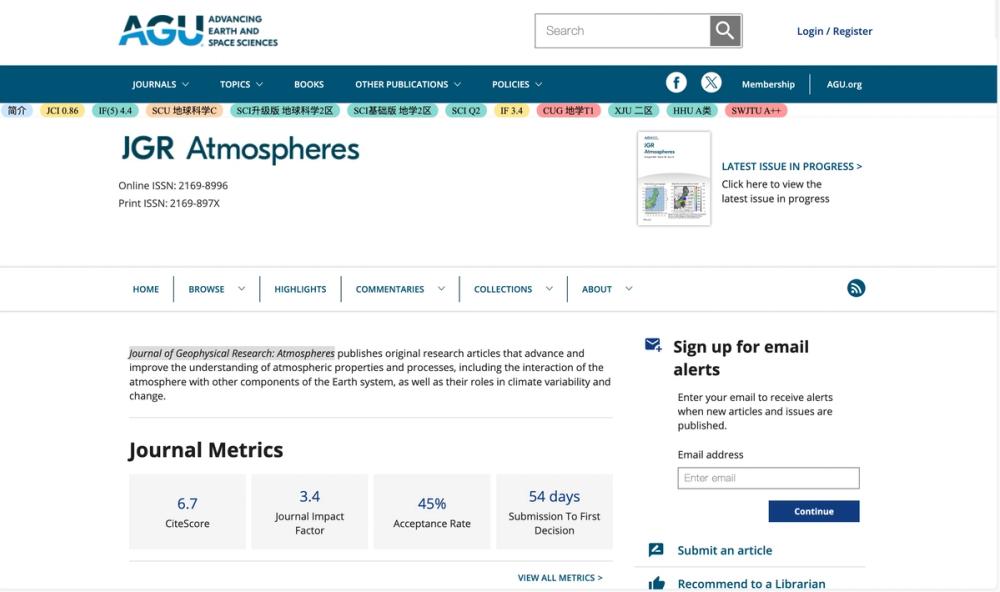Name: Journal of Geophysical Research: Atmospheres
Link: agupubs.onlinelibrary.wiley.com/journal/21698996
Description: Journal of Geophysical Research: Atmospheres is a peer-reviewed journal publishing original research that advances understanding of atmospheric properties, processes, and their interactions with Earth's systems and climate.
Key Words: atmospheric science, peer-reviewed, original research, climate variability, Earth system interactions, geophysics, atmospheric processes
Introduction:
The Journal of Geophysical Research: Atmospheres (JGR: Atmospheres), published by the American Geophysical Union (AGU) and Wiley-Blackwell, is a premier peer-reviewed scientific journal dedicated to advancing the understanding of atmospheric properties and processes. Established as part of the broader Journal of Geophysical Research family, which began in 1896 under the name Terrestrial Magnetism, the Atmospheres section (designated as JGR-D) has been a key platform for atmospheric science research since its formalization in 1980. The journal focuses on original research articles that explore the physics, chemistry, and dynamics of the atmosphere, including its interactions with other components of the Earth system, such as the oceans, land surface, and biosphere, as well as its role in climate variability and change.
JGR: Atmospheres publishes high-quality, novel research with significant implications for atmospheric science and related fields. Its scope includes topics such as atmospheric composition, aerosols, cloud physics, weather systems, climate dynamics, and the impact of atmospheric processes on global and regional climate change. The journal also covers interdisciplinary studies, such as the role of atmospheric rivers, mesoscale convective systems, and tropical cyclones in extreme precipitation events, as well as the influence of atmospheric circulation patterns like ENSO on nitrogen deposition and precipitation trends. Recent studies have also explored innovative topics like the optical properties of atmospheric black carbon and thunderstorm electric fields producing gamma-ray glows.
The journal employs a rigorous peer-review process to ensure scientific quality, with submissions evaluated by expert editors and reviewers for originality, scientific significance, and clarity. Manuscripts are submitted through the AGU’s online system (GEMS), where authors must adhere to strict guidelines, including a maximum of 25 publication units (1 PU = 500 words or one figure/table), a structured abstract of up to 250 words, and a Plain Language Summary for broader accessibility. The journal encourages open science practices, such as registering samples with International Geo Sample Numbers (IGSNs) and linking datasets to repositories, to enhance reproducibility and data accessibility. Papers published in JGR: Atmospheres become fully open access 24 months after publication, reflecting AGU’s commitment to inclusive science.
With an impact factor of 4.4 in 2024 and an h-index of 137, JGR: Atmospheres is highly regarded in the fields of atmospheric science, geophysics, and Earth and planetary sciences, ranking in the top quartile (Q1) of journals according to SCImago Journal Rank (SJR). It is indexed in major databases like Web of Science, Scopus, GEOBASE, and PubMed, and has published influential papers, such as those on dust emissions, volatile organic compounds, and geomagnetic polarity timescales, some garnering over 1,000 citations. The journal’s editorial board, led by Editor-in-Chief Yafang Cheng, comprises leading experts who uphold high standards of scientific integrity and foster interdisciplinary research.
JGR: Atmospheres also supports special issues and encourages companion papers to coordinate related research across journals. Its commitment to accessibility is evident in policies promoting colorblind-friendly figures and clear communication for non-specialist audiences. With a global readership and a focus on cutting-edge atmospheric research, JGR: Atmospheres remains a vital resource for scientists studying the complex dynamics of Earth’s atmosphere and its critical role in the broader Earth system.




